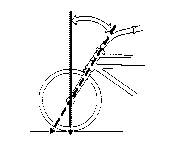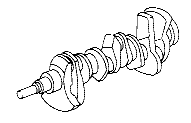C-Pillar or C-Post
The rear or back window pillars that support the rear window and the rear portion
of the car's roof.
CAFE
The acronym for Corporate Average Fuel Economy. This single mileage figure is determined
by taking a sales weighted average of the fuel consumption for all models produced by a
manufacturer. The minimum required figure is an established U.S. government standard.
Manufacturers which do not meet the minimum standard are fined.
Caliper
The part of a disc brake assembly that straddles the disc and contains the
cylinders, pistons and brake pads. It is also the portion of the brake system that moves
as a result of hydraulic pressure.
Cam
A. A slang expression for camshaft. (See: Camshaft)
B. In the strict engineering sense, a cam is an eccentric or irregularly shaped part that
rotates and imparts motion to other parts. All Nissan products use either single or dual
overhead cam engines.
Camber

Camber is defined as the inward or outward tilt of the top of the tire, as viewed from the
front. Wheel camber is zero if the tire centerline is parallel to true vertical.
If the tire is tipped outward at the top, it
has positive camber

If the top of the tire is tipped inward, the tire has
negative camber.

Camshaft
A shaft in the engine that is driven by gears, belts or a chain from the
crankshaft. It contains a series of cams for timing the opening and closing of the intake
and exhaust valves.
Carburetor
A device through which air is drawn into the engine and mixed with fuel to form a
combustible mixture that can be burned in the engine's cylinders. The carburetor changes
the ratio of fuel and air according to varying engine operating conditions such as
starting, idling, cruising and maximum power. Carburetors are relatively inefficient. All
Nissan vehicles use some type of fuel injection instead of a carburetor. (Also see: Fuel
Injection)
Caster
The forward or backward tilt of the steering axis as viewed from the side. If the
point of load is ahead of the point of contact, the caster angle is positive. An example
of caster is the bicycle. The front fork/steering head is tilted back at an angle. This
provides caster effect, since the point of load is out in front of the point of contact
and gives the stability necessary to ride with "no hands". (Also see: Steering
Axis Inclination)

Catalytic Converter
A muffler-like device in the exhaust system that usually
contains platinum or palladium as a catalyst to produce a chemical reaction. It converts
hydrocarbons and carbon monoxide into water vapor and carbon dioxides thus reducing
emissions.
Chassis
The frame with all the operating parts, including the
engine, drivetrain, suspension and brakes, or the car minus the body, accessories and
trim.
Center of Gravity
The single point of a vehicle's concentrated mass which is used to calculate
numerous handling parameters.
Closed Crankcase Ventilation (CCV)
A system in which crankcase vapors are discharged into the engine intake system
(usually via the intake manifold) where they are burned during the combustion process
rather than being discharged into the atmosphere.
Clutch
A friction type of uncoupling device used to disengage an engine from the
transmission during shifting. Clutches are normally linked to a clutch pedal in the
driver's compartment so that the driver can control clutch operation. When a driver pushes
down on the clutch pedal, a linkage forces a plate to move. This movement releases the
engagement pressure from the friction disks. When the pressure is released from the clutch
plate, the power flow is interrupted and the engine runs without transmitting any power to
the power train.
CO
Carbon monoxide. A colorless, odorless, highly toxic gas compound produced as a
by-product of combustion in a gasoline engine.
Collapsible Steering Column
A column either jointed or fitted with a special collar designed to crush on
impact, preventing . serious injury in a front-end collision. All Nissan vehicles have
collapsible steering columns.
Combustion Chamber
The volume of space at the top of the cylinder where burning of the air/fuel
mixture begins. The size of this chamber, as well as the size of the piston dish (or dome,
which effectively decreases combustion chamber volume), largely determines an engine's
static compression ratio (see below).
Compression Ratio
This refers to the extent to which the air/fuel mixture is compressed within the
cylinder during the compression stroke of the engine.
Compressor (Air Conditioning)
The mechanism in an air conditioner that pumps vaporized refrigerant out of the
evaporator, compresses it to a relatively high pressure, and then delivers it to the
condenser.
Condenser
A device for storing electrical energy. In A/C application, an air conditioning
component used to remove heat from the inside of a vehicle.
Connecting Rod
Internal part of the engine which connects the piston to the crankshaft

Constant Velocity Joint
Constant velocity (or CV) joints are a refined version of a universal joint which
eliminate the torque variations or vibrations which are inherent in an ordinary U-joint
that is being operated at an angle. Nissan uses CV joints in all front wheel drive
vehicles and in the independent rear suspension driveshafts of the 300ZX and 240SX. (Also
see: Universal Joint)
Contact Patch
The area of a tire's tread that is in contact with the ground.
Coolant
The mixture of water and anti-freeze that picks up heat from the engine and
transfers it to the air passing through the radiator. This transfer of heat keeps the
engine operating within its optimum temperature range preventing premature engine wear.
Coolant Recovery System
Part of the engine cooling system, it consists of a container coupled to the radiator, so
that when a radiator overflows, the container stores the liquid, eliminating the need to
open the radiator for refilling.
Cooling System
The system that removes heat from the engine. It includes the coolant, radiator,
fan, water pump, thermostat and water jackets in the engine.
Core Plug
Steel plugs, slightly dished or cup shaped, inserted into holes in the engine
block that were created during the casting process of the engine block. These holes open
into cooling passages and are usually located in the lower half of the block. (Also
referred to less accurately as expansion pit or freeze plugs.)
Cowl
The portion of a car's body between the engine compartment and the passenger
compartment. It normally houses the instruments and the plenum chamber for the
heater-ventilation system. (Also see: Plenum Chamber)
Crankcase
A case that encloses the crankshaft. In most engines, the oil pan and the lower
portion of the cylinder block form the crankcase.
Crankshaft
The main shaft of the engine, so named because of the U-shaped cranks. The
crankshaft converts the reciprocating motion of the pistons and rods to rotary motion and
delivers it to the front and rear of the engine. The main bearings are part of the
crankshaft assembly. Nissan four-cylinder engines turn on five main bearings, and our V-6
engine has four main bearings.

Crossmember
One of several horizontal members in a vehicle frame which join the side members
and add to overall strength and stability.
Curb Weight
The weight of a vehicle with standard equipment, oil, lubricants, coolant and
full tank of gas.
Cylinder Block
The basic part of the engine to which other engine parts are attached. It is
usually a casting and includes engine cylinders and the upper part of the crankcase.

Cylinder Head
A detachable part of the engine that attaches to the cylinder block, seals the
cylinders and contains the combustion chamber. It has water and oil passages for cooling
and lubrication; it holds the spark plugs and the valves.
BACK
NEXT |
![]()